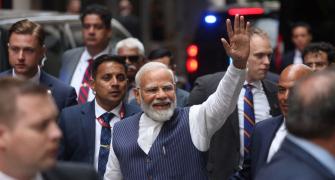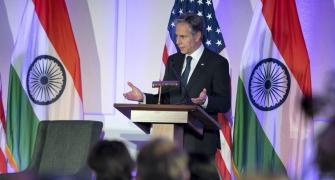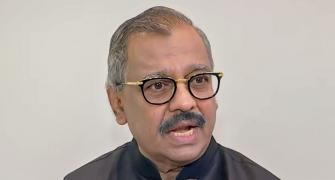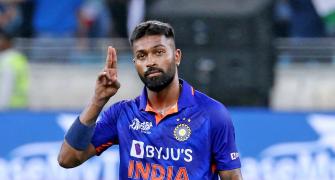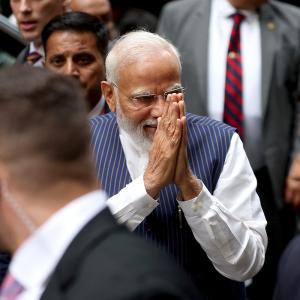'The Modi visit will prove to be the watershed where India and the United States commenced technology trade and transfer.'

"Today, India-China-US are the three largest economies in the world in PPP (purchasing power parity) terms. If any two of them come closer to each other, it will be alarming or discomforting to the third," says Ambassador Gautam Bambawale, India's former envoy to China, Pakistan and Bhutan.
"It is now increasingly apparent that the United States is willing to sell technologies and products to India which it never transferred or sold to China. From that perspective, the strategic as well as tactical proximity of India and the US must be looked at with suspicion and distrust in Beijing," he says in an e-mail interview to Rediff.com's Archana Masih.
You mentioned in a television interview that this visit was an 'inflection point' in India-US ties. Can you elaborate on that thought?
What are some of the deals struck and agreements made that may have been unthinkable in the past?
India-US ties have been strengthening steadily since the visit to India of then US President Bill Clinton at the invitation of the then PM of India, Mr Vajpayee.
This steady progress in our relationship has continued through the periods of leadership in the United States of Presidents George W Bush, Obama, Trump and now President Biden.
Similarly, on the Indian side, such forward momentum has been maintained through the prime ministerships of Mr Vajpayee, Dr Manmohan Singh and now Mr Modi.
The important point here is that improving and expanding bilateral relations is supported by all political parties whether in India or in the States.
When you look back over the past 20-odd years, you will see that the steady upward graph in India-US relations have from time to time been given a forward impetus which I call an 'inflection point'.
The visit to India of Bill Clinton was one such moment in time.
The India-US nuclear deal in the period 2005 to 2008 under the leadership of President George W Bush and Prime Minister Manmohan Singh was another such moment.
The just concluded visit to the United States by PM Modi is also an inflection point which has pushed the relationship into a higher orbit or trajectory.
This is an inflection point because for the first time the United States has agreed to transfer sensitive and fairly high-level technology to India.
In the past, all countries have been reluctant to do so including the US. Such technology is coming to India either through co-production and co-manufacturing of GE-F414 jet engines, or through joint training and joint missions in the field of space exploration, or through foreign direct investment by US firms in the semi-conductor and chips sector, or through the many areas of the i-CET program in critical and emerging technologies.
So, the Modi visit will later -- as we look back on it -- prove to be the watershed where India and the United States commenced technology trade and transfer which in turn can be ascribed to the high levels of trust and confidence in each other.
This is why I call this visit an 'inflection point'.

Why do you think the US was reluctant to share technology with India in the past? And what has changed now that it has decided to do so now?
In the past, India and the US were on opposing sides of the geo-political fence.
For example, during the Cold War period, there was no question of US companies sharing sensitive technology with us nor were they permitted to do so by the US government.
After the Cold War too, such trade and transfers were not allowed as confidence and trust in each other was still very low.
Since the turn of the century and the Clinton visit to India, we have got more comfortable with each other because we have had many more conversations, discussions, even dis-agreements.
Such interaction has taken place not merely between the leaders of India and the United States, but also amongst the bureaucracies, the militaries, firms and companies, academicians, technologists, space scientists, and ordinary people of both sides.
Through such interactions has come an understanding of the thinking of the other side.
The result has been greater trust and confidence.
Such mutual understanding has led to the current breakthrough to transfer sensitive technologies.
We must also factor in that today India is the fifth largest economy in the world with GDP of $3.75 trillion.
It is the fastest growing major economy, with a large market and with capabilities which few other nations have.
India is soon expected to be the third largest economy in the world.
Such changes have created the economic conditions for tech transfer and cooperation.
Meanwhile, geo-politics has also turned full cycle and today many of India's national interests overlap those of the US - A multi-polar Asia and a rules-based Indo - Pacific are in both countries interest.
The shared values of democracy and upholding the rights of the individual also bind us together.
These are the reasons the United States is ready to transfer technology to India.

How intently or minutely do you think China was watching this state visit?
How is the strategic proximity of India and the US as displayed last week being interpreted in Beijing?
Today, India-China-US are the three largest economies in the world in PPP (purchasing power parity) terms.
If any two of them come closer to each other it will be alarming or discomforting to the third.
Hence, PM Modi's State visit to the United States was surely tracked, analyzed and dissected by Beijing.
What their conclusions are and how they will respond remains to be seen.
It is now increasingly apparent that the United States is willing to sell technologies and products to India which it never transferred or sold to China.
From that perspective, the strategic as well as tactical proximity of India and the US must be looked at with suspicion and distrust in Beijing.
However, it must also be kept in mind that it is China's aggression over the past few years epitomised by its 'wolf warrior diplomacy' and its assertive actions all over the globe which provides the glue to US-India relations.
So, in a sense Beijing is reaping what it sowed.

What could be the guarantees or assistance or assurances that both countries would have given each other in dealing with their respective challenges with China?
India and the United States have a global strategic partnership. Both are big countries with capabilities of their own.
The successful State visit to the US of PM Modi is a message by and in itself.
The fact that the United States is willingly transferring and co-producing jet engines and its technology to India is a statement by itself.
The fact that American firms are wanting to establish reliable and resilient supply chains in semi-conductors by investing and manufacturing in India is a message in itself.
The fact that India has signed the Artemis Accords and NASA will train Indian astronauts and they will undertake a joint mission to the International Space Station is clearly an indicator of the depth of the relationship.
I could go on and on with examples from the just concluded visit of PM Modi.
I won't because I think I have made my point -- India and the United States have clearly signaled to the world how close their ties are today.
Moreover, the world has taken notice of this development.

If you look back at the progress of India-US relations over the decades, what have been the key turning points that have brought us thus far?
Post India's nuclear tests of 1998, we were sanctioned severely by the US. The series of Jaswant Singh-Strobe Talbott discussions thereafter was important in enhancing understanding on both sides. Then followed the Clinton visit to India and proved to be a key inflection point in the relationship which improved dramatically.
The next key turning point was the India-US nuclear deal of 2005 to 2008.
It enabled India to be recognised as a responsible nuclear power and not as a nuclear pariah.
It also showed the support India had in the US Congress across the political aisle.
Simultaneously, defence ties began growing and has become a key aspect of the bilateral relationship.
The visit to the US by PM Modi and the understandings and agreements reached before and during the visit is another inflection point in bilateral ties due to the salience and importance it places on technology cooperation between the two sides.
This visit will raise relations to a new level or take them to a new, higher orbit.
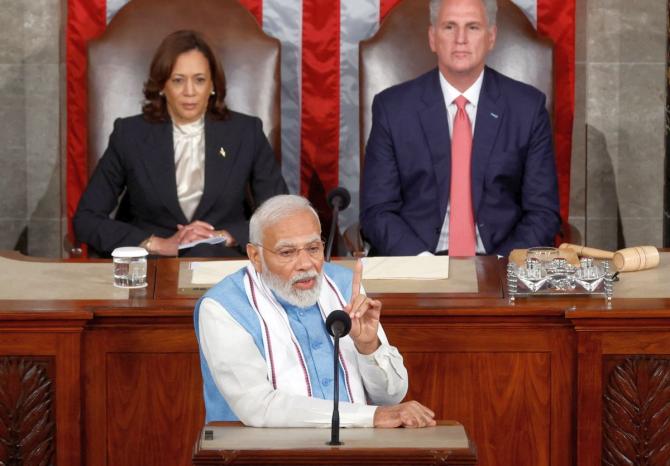
White House officials have termed bilateral ties with India as the 'most consequential' relationship for America.
In what ways is the future of India-US relations going to be different from here on?
There will be a steady enhancement and strengthening of the relationship on this new trajectory that we are on.
There are bound to be greater economic exchanges between us as India grows.
From now on this will also take the shape of both nations and both societies working closer on new cutting-edge technologies.
Any breakthroughs will benefit the whole of humanity.
So, this partnership between two of the biggest countries and economies of the globe is for global good.
Our cooperation has implications for greater employment, better lifestyles and cleaner environment standards not merely for our two countries but for all nation states.
This will be the true impact of this 'most consequential' relationship between India and the United States.

India's foreign policy which has always followed the path of self interest is a reason for disquiet among some skeptics in the American security establishment vis a vis China.
What shadow is this likely to cast on the future of this relationship?
What became apparent during PM Modi's State visit to the United States is that such a view is not shared by Americans in the administration.
It is a viewpoint vocalised merely by a handful of sceptics outside government.
It is not widespread even amongst academics and think-tankers.
Unfortunately, such pessimism and scepticism is passed off as analysis these days.
We should not take it seriously. The majority of Indians and Americans expect bilateral relations to bring great benefits for both countries and the world at large.
Naturally, bilateral India-US ties will lead to serving the national interest of each country.
At the same time, it does not mean that India and the United States will have exactly overlapping interests or positions on each and every issue in international relations.
Our partnership is mature enough to understand this and to factor it into our relationship.
To quote Prime Minister Modi, even the sky will not limit bilateral cooperation.
Feature Presentation: Aslam Hunani/Rediff.com


